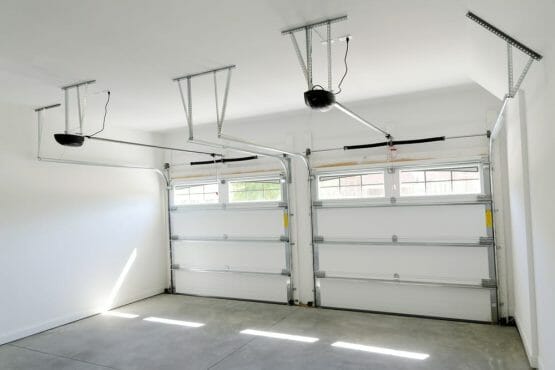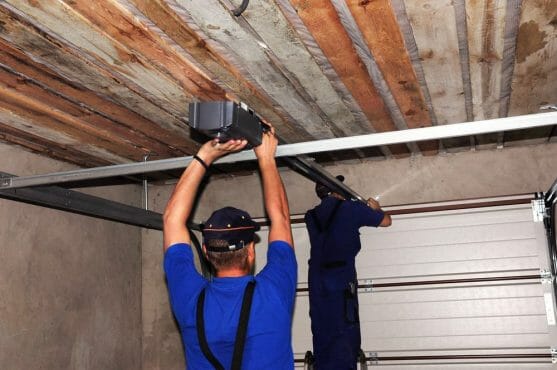Quick Navigation
- How Do Garage Door Sensors Work?
- Are Garage Door Sensors Required?
- How Do You Know if Garage Door Sensors are Bad?
- Can You Disconnect Garage Door Sensors?
- How to Bypass Garage Door Sensors Safely
- 1. Make Sure the Door is Either All the Way Closed or the Opening is Propped Up From Underneath
- 2. Locate and Drag Down the Manual Release Cord
- 3. Remove Your Props and Close the Door Gently
- 4. Cut Off the Power to the Safety Sensors
- 5. Remove the Sensors from the Door Assembly
- 6. Cut the Wires Off These Old Sensors
- 7. Attach the Wires of the New Sensors to Your Garage Door System
- 8. Slot the Sensors Back Into Their Housings
- 9. Turn the Power Back On and Test the System
- Make Sure You Protect The Safety of Your Home While Undergoing Garage Door Opener Maintenance
Garage door sensors are safety mechanisms that won’t allow the door to close if something is blocking their beam of light. This safety feature was made standard in the early 1990s to avoid unnecessary injuries.
While we can all appreciate these sensors they can become a nuisance if they start to malfunction. Here we will discuss how garage sensors work, how to tell if your garage sensors are bad, and how to bypass garage door sensors in the meantime so you can open and close the garage door manually.
How Do Garage Door Sensors Work?
With the continued surge in suburban popularity and the sheer number of garages attached to homes, the number of unintended deaths of children due to garage doors falling accidentally became unsettling in the early 1990s.
The legislation was put in place requiring garage door sensors to be placed on every garage door in 1993. But, how do the sensors work? How does the system know there is something blocking the way?
Garage door sensors utilize a photo-eye sensor and a beam of infrared light that goes between the two units. The units are placed near the ground on either side of the garage door. If the beam of light is interrupted while the garage door is closing the door will stop and rise back up.
Do Both Garage Sensors Need to Be Green?
When you inspect your garage door sensors you’ll notice each has a light. This light will either be red or green.
The light of both sensors should be green if the unit is functioning correctly. This confirms that the beam of infrared light is being produced and read by both sensors.
If one is green and one is red, or they are both red, there is something wrong with the system. This could be as simple as a slight variance in the angle or could mean the entire system is faulty.
Are Garage Door Sensors Required?

According to the United States legislation put in the books in 1993, every garage door installed on a home in America is required to have garage door sensors installed for safety.
In order for your garage to pass inspection, it must have a functioning sensor system.
How Do You Know if Garage Door Sensors are Bad?
Are your sensors not working properly? There are six ways to tell why your sensors are malfunctioning. Check each one before you attempt to bypass the system so you know what you’re dealing with.
1. Check the Sensor Path
Make sure there is nothing blocking the beam of light. The beam is pretty sensitive so this could even be a thick spider web or leaf. Search all along the path and make sure to wipe off both sensors to make sure there is nothing blocking the path.
2. Confirm the Sensor Power is On
Check to find the lights on the two sensors. If they aren’t lit up you have a power supply issue.
Make sure that each sensor is connected to its power supply and confirm that the lights are back on. The system should run normally now that the power is back in place.
3. Clean the Sensor Lenses
A garage is a dusty and dirty place. Dirt and/or mud may have gotten caked onto the sensor lens of one or both of the units. Every once in a while give them a nice wipe to remove any build-up.
4. Dry the Sensors Off
Has it been raining a lot? Did you drive into the garage while it was coming down?
Your sensors might be wet. Make sure you completely dry the units and then test the system again.
5. Make Sure Your Sensors Are Aligned
Check each sensor to see if anyone inadvertently kicked one or hit it with the garbage can. These little taps can knock the sensors out of alignment.
Even if the alignment is slightly out of place it can make the system run inefficiently and malfunction.
6. Check Sensors Often for Wear and Tear
Sensors, like any piece of electrical equipment in your home, get old and start showing wear and tear eventually. Check each sensor for signs of age and if they are looking beat up it’s time to think about replacing them.
Can You Disconnect Garage Door Sensors?
So you’ve gone through all the simple solutions and your garage door is still giving you trouble. You absolutely can disconnect the garage door sensors in this case.
However, you have to know what you’re doing and make sure you follow some safety protocols to avoid inadvertent injury.
How to Bypass Garage Door Sensors Safely

Make sure you’ve checked all the preliminary easy fixes before you begin your project. If you have determined that you do have to replace the sensors you’ll need to bypass the sensors. Bypassing garage door safety sensors should only be done once you’ve confirmed there are no other options to get them working properly.
Here’s how to bypass garage door sensors safely.
What You’ll Need for the Project
There are a few supplies you’ll need to gather to get the job done right:
- Wooden brace or another object to prop the door if it’s stuck open
- Wire cutters
- Pliers
- A new set of sensors
1. Make Sure the Door is Either All the Way Closed or the Opening is Propped Up From Underneath
If your garage door is stuck closed you’ll simply want to make sure the door is firmly closed. If it’s stuck open and you can slide it closed easily it’s better to do that than leave it open.
If the door is closed or you can slide it down, make sure the system is switched into manual mode. This will prevent the automated features of the system from operating.
If the door stays open and can’t be pushed down make sure to place a few different props underneath the door. When you switch the door to manual it can slam shut and that can damage the door and the frame. Make sure whatever you use is strong enough to bear the weight of the garage door.
2. Locate and Drag Down the Manual Release Cord
Every garage door comes with an emergency manual release cord attached to the automatic system. After you’ve pulled it the automatic system can no longer work because it will have been pulled from the track.
3. Remove Your Props and Close the Door Gently
Now that the manual cord has been pulled the door won’t slam shut on its own. Go ahead and remove your props and slide the door closed carefully. Make sure to watch your toes.
4. Cut Off the Power to the Safety Sensors
Find the power source for the sensors and the garage door system. It may be run with a switch or be plugged into the wall. Either way, turn off the power or unplug the system.
This is an important step for safety because you’ll be playing with wires next. You do not want to get an unexpected shock.
5. Remove the Sensors from the Door Assembly
Now that the power is off it’s safe to remove the sensors themselves. Undo the wingnut holding the sensors in place and remove them.
6. Cut the Wires Off These Old Sensors
Using your wire cutter snip the wires that continue to attach the sensor to your garage door. You can cut close to the sensor. Give yourself only about a half-inch from the sensor.
7. Attach the Wires of the New Sensors to Your Garage Door System
Now that you have your hanging wires use your pliers to strip some of the casing back and expose the wires. Connect these wires to the wiring of the new sensors.
Match like colors to like colors, there are usually a black wire and a white wire.
8. Slot the Sensors Back Into Their Housings
Once the wiring is connected all that’s left is slipping the sensors back into the housings and retightening the wingnuts.
9. Turn the Power Back On and Test the System
If you’ve done your job right all should be well with your garage door system and all will go smoothly. If anything goes haywire and it doesn’t work it’s a good time to call a repairman.
Make Sure You Protect The Safety of Your Home While Undergoing Garage Door Opener Maintenance
We hope you understand more about how to bypass garage door sensors and fix your issue.
Your garage door sensors do more than keep people and pets going under them safe. It also allows your garage door to automatically lock and automatically secure itself in modern models.
If your sensors are broken and there is going to be a lapse in between discovering the problem and when you can replace the sensors you’ll want to add additional security to your property.
Check out our recommendations for the best outdoor wireless security camera with DVR and the best driveway alarm to add an extra level of security while your garage door is malfunctioning.
Do you have other questions about maintaining a safe and secure home? Contact me now and I’ll be happy to offer my advice.

